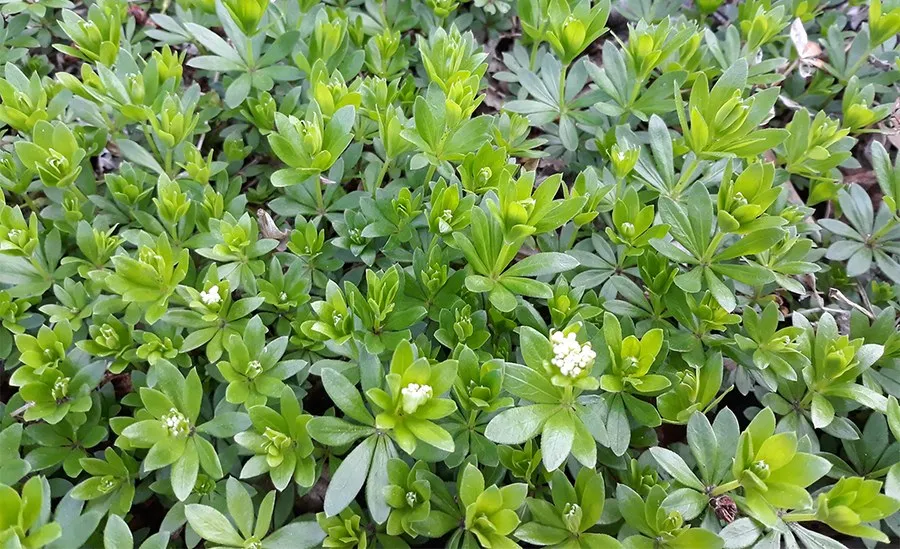Sweet Woodruff in the Garden and the Kitchen

Sweet Woodruff in the Garden
This small, 6-12 inch tall, quick-spreading ground cover grows well in partial to full shade, thus in our woodland gardens. The dark green leaves, between six to eight leaflets, whorl up and down around a square stem creating an illusion of a little tree. A patch of sweet woodruff could mirror the forest canopy above and a miniature forest along the ground, as each plant spreads between 1 to 2 feet wide. The leaves are evergreen, making for an ideal ground cover throughout the seasons.
Some gardeners may enjoy having such an enthusiastic ground cover. Sweet woodruff spreads by slender rhizomes and thrives in moist, well-drained loam or amended soils. It is tolerant of drier soils and the juglone produced by black walnut trees. While it is hardy throughout USDA Plant Hardiness Zones 4-8, its habit is much more well-behaved and tidier in cooler areas. It is non-native, originating from North Africa, Asia, and Europe, and a member of the Rubiaceae, madder family.
If sweet woodruff does become aggressive in the landscape, be careful with its removal. Make sure to loosen the soil around the plant to remove all the rhizomes. Simply pulling at the stems may not be effective, as they are tender and break easily.
The sweetly fragrant flowers are four-petaled (star-shaped) and white. They rest at the terminals of the stems in cymes, flat-topped inflorescences. They bloom in cymes, loose clusters of flowers at the end of stems rising above the foliage. Sweet woodruff blooms in the spring, usually sometime around early May. The blooms coincided with May Day celebrations in the United States and Beltane celebrations in Europe and thus have been used in many recipes surrounding the holiday.
Sweet woodruff can be propagated by its rhizomes and its fruit. The tiny fruits are covered in hooked bristles, allowing them to travel on fur and clothing. Be mindful of not aiding its spread into unwanted spaces in your garden.
Combine sweet woodruff with spring bloomers such as Virginia bluebells (Mertensia virginica), bellwort (Uvularia grandiflora), Dutchman’s breeches (Dicentra cucullaria), and columbine (Aquilegia canadensis), to provide a green backdrop for these beauties. Or add sweet woodruff in with other ground covers such as wild ginger (Asarum canadense) or common blue violet (Viola sororia) to mix textures and shades of green.
Sweet Woodruff in the Kitchen
Sweet woodruff does not have much scent until it is dried. Once dried, its aroma has been compared to hay, almonds, and vanilla. Though not used much in the United States, sweet woodruff has a very long history in Europe, especially in Germany. In the Middle Ages, dried sweet woodruff was stuffed into mattresses and pillows and used to refresh clothing. It is used in potpourris, sachets, and wreaths.
For the best fragrance, harvest clean stems just after the flower blooms. Cut sprigs and hang them to dry in bundles in a warm, dark, and dry location. Alternatively, a dehydrator set at a low temperature (95° to 115°F) also works well. Once the leaves are crispy, strip them from their bitter stems with clean, dry hands and store them in an airtight container in a cool, dark, dry location. Sweet woodruff retains its scent and flavor for a long time, though the standard advice is to use dried herbs within one year.
Sweet woodruff is an edible herb and has many culinary applications. Perhaps it is most famously known for being infused in a light German white wine, such as a Reisling, and consumed as part of their May Day celebrations. This German wine is an acquired taste.
There are no research-based recipes for making jams and jellies, but it is safe to create teas, syrups, other infusions, and frozen desserts like sorbet, sherbet, and ice cream. The sweet woodruff-infused simple syrup can be added to all sorts of culinary creations. Poke holes into and pour over a pound cake. Add syrup to sparkling water, cocktails, or sparkling wine for a refreshing flavor.
Sweet Woodruff Tea
Steep 1 teaspoon of dried leaves in one cup of boiling water for 5 minutes. Strain and enjoy straight or sweetened with sugar or honey. This is a nice relaxing evening tea.
Sweet Woodruff Simple Syrup
- 1 cup sugar
- 1 cup water
- 1 handful of dried sweet woodruff leaves (from about 3 handfuls of fresh leaves)
- Heat water and sugar until dissolved
- Add leaves and simmer for 5 minutes
- Remove from heat, cover, and let steep for up to 3 hours or until the desired intensity of flavor is achieved
- Strain and pour into a sterilized jar
- Cover and store in the refrigerator and use within 2 weeks, or freeze for later use. If freezing, use a freezer-safe jar and leave plenty of headroom to account for expansion.